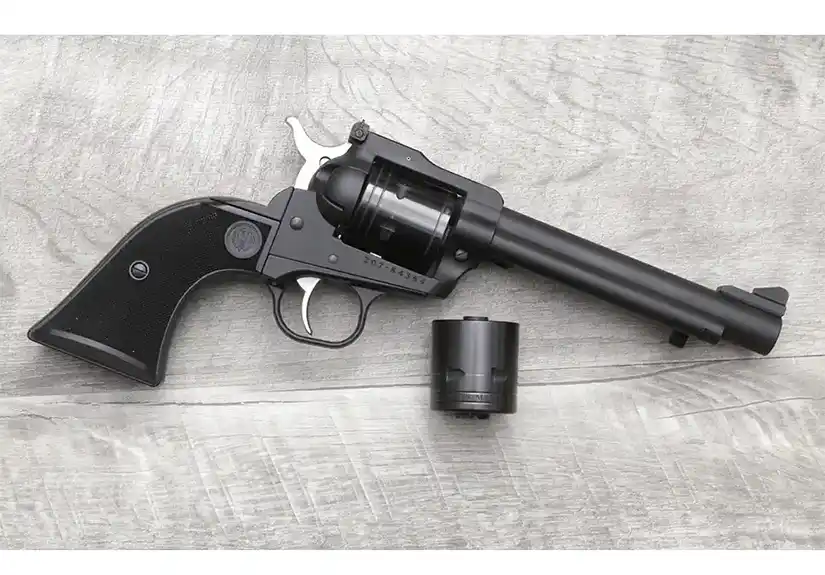With the release of their new Super Wrangler, Ruger hit the sweet spot in single-action rimfire revolvers. If Goldilocks was shopping for a new SA .22 LR, this would be it. Ruger’s original Single-Six is a fine revolver, but the Convertible model’s current $799 MSRP makes it a tough choice for someone looking to plink, cowboy-style. At the other end of the spectrum is their Wrangler, which has neither adjustable sights, nor the .22 WMR cylinder option, but a more budget-friendly MSRP of $269. Plenty of Wrangler reviews mention “If only”. As in, “if only it had adjustable sights”. Or “If only it had an optional .22 MWR cylinder”. Ruger answered that with the Super Wrangler, which has adjustable sights, an included .22 WMR cylinder, and a “just right” MSRP of $329. For the modest price increase over the Wrangler, it feels a lot closer to the Single-Six too.
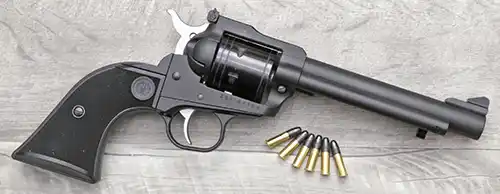
Ruger Super Wrangler specs
Ruger ships the Super Wrangler is a cardboard box with the .22 LR cylinder installed, and includes the .22 WMR cylinder as well. Built around an alloy steel cylinder frame, the Super Wrangler weighs 37.7 ounces. Accuracy and long life are ensured by the 5.5-inch cold hammer-forged barrel. It’s a 1:14″ right-hand twist, which should work well for both .22 LR and .22 WMR. Up front, the ramped sight is grooved to minimize reflections. And at the rear is a sight adjustable for windage and elevation. For safety, there is a transfer bar mechanism, so it can be carried with a full cylinder. Overall length is 11 inches.
Like its siblings, the Super Wrangler features an alloy grip frame. Dimensionally, it’s the same as the Single-Six, so any grips that fit one will fit the other. So if you don’t like the checkered synthetic grips that it comes with, don’t worry. There are plenty of other options. And while the Super Wrangler is currently available in black, silver, or bronze Cerakote, I would not be surprised if the color choices are expanded a bit over time.
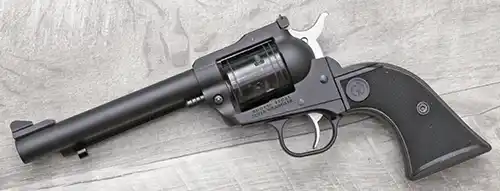
Super Wrangler first impressions
I’ve handled plenty of Wranglers, yet never bought one. Mostly because they just didn’t seem to have the level of quality I wanted, although they are priced affordably. While I don’t think it was just due to the weight, the extra mass of the Super Wrangler certainly makes it feel a bit more substantial. Adding nearly a half pound to a rimfire revolver can do that. It does seem to be finished a little better as well. For those curious, the Super Wrangler barrel is slightly larger in diameter when compared to the Single-Six. It also lacks the cylinder fluting of the .22 LR cylinder. Other than that, I’ll say it again – the Super Wrangler feels closer to the Single-Six than the Wrangler. This is a good thing.
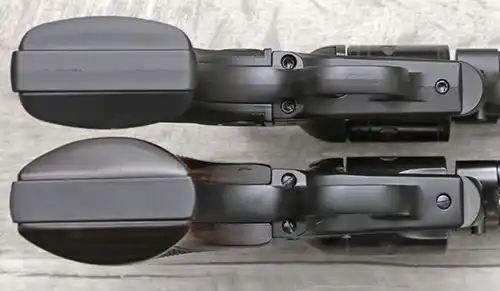
Comparing the Super Wrangler’s fit and finish to the Single-Six may not be fair, given the massive disparity in MSRP. But the Super Wrangler doesn’t give up much. There is an obvious difference between the cylinder frame to grip frame fit. Yet it’s not objectionable. The biggest standout is the parting line on the underside of the grip frame. It’s not terrible, but it’s visible. Sure, Ruger could have knocked that off with a few passes of emery paper. But adding even a few dollars to the cost, for something most users don’t care about, wasn’t part of the plan. A little less machine time and a little less finish time keeps the cost down. Ruger put their money into the frame, sights, and barrel, where it counts the most.
Loading, reloading, and swapping cylinders
Loading the Super Wrangler is accomplished by opening the loading gate and dropping rounds in one at a time while turning the cylinder. To eject empties, open the gate, tilt the barrel up, and use the spring-loaded ejector rod to push out the spent brass. It’s not fast, and it’s a good reminder of why two revolvers were commonly carried back in the day.
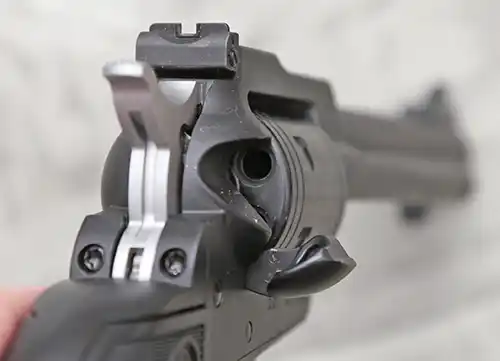
Swapping cylinders is a fairly simple process. Open the gate again, and press the base pin latch (button) on the left side of the frame, just forward of the cylinder. From there, the base pin can be pulled out, allowing removal of the cylinder through the right side of the frame. Replace it with the cylinder marked .22 WMR and reinstall the base pin. Note that the magnum cylinder is marked as such, although the .22 LR cylinder is unmarked.

Range time
I ate plenty of soup and tuna in the week leading up to my review. My dog did his part too, so I had three different sizes of cans. We lined them up, loaded up, and went to town. Thumbing the hammer back results in a short, somewhat heavy trigger pull with little creep and a decent break. Having an adjustable rear sight was immediately appreciated. With cheap bulk ammo, the Super Wrangler was shooting a few inches high at around 15-20 yards. A quick adjustment resolved that, and I was able to easily make all three can sizes dance around on the ground. With each shot, they got a little further away, but were still easy to hit. I’m no Wyatt Earp, but the Super Wrangler is more than accurate enough for me. I’m sure with practice, it would be fine for taking small game up close.
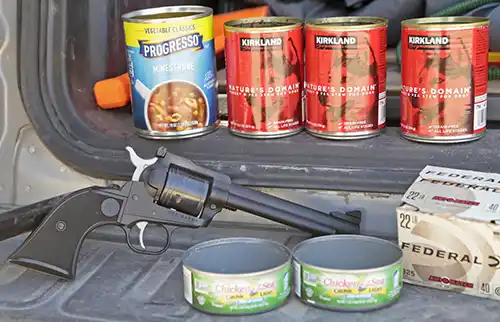
Speaking of small game, the .22 WMR certainly delivers enough energy for that task. So I swapped the cylinder and proceeded to ring a 4″ steel gong at around 25 yards. Although there was definitely more noise, recoil was still pretty much non-existent. And the sound of those rounds hitting steel was very satisfying, if a little wasteful. There’s no inexpensive option for any magnum rounds these days. I should mention that I had zero issues with the .22 LR or .22 WMR ammo over several hundred rounds. All of it went bang every time. And empties dropped right out.

Conclusion
The single-action rimfire revolver space has been a little crowded over the past few years. It’s a popular niche, as rimfire has always been the most affordable ammo. And the allure of an old-school western-style six-shooter has immense appeal to a broad range of shooters. So there are some very inexpensive models, with quality to match their low price. At the other end is the “heirloom” models, with prices that negate the cheap cost of ammo. And not too much in the middle, until now. Which is what the market needs, really – a combination that shoots affordable .22 Short, Long and Long Rifle. With the option (at no extra cost) to shoot the more powerful .22 WMR round. Versatility and value.
As mentioned, I have yet to buy a Wrangler. Despite the modest price, it’s been a hard pass for me. I generally buy firearms that are going to last. And I never felt that the with the Wrangler. Especially when I had a Single-Six in my safe. It just didn’t make sense. Ruger’s new Super Wrangler changes that. If you prefer a blued or stainless finish, the Cerakote may not be for you. Otherwise, it’s about 80% of the Single-Six’s quality, at less than half the price. If I didn’t already have that Single-Six, the Super Wrangler would be an easy choice. The weight lends a feeling of quality, while the sights allow for better accuracy. And it’s nice to have the option of the more powerful .22 WMR too. It’s just a win all around.
As always, I would like to thank Ruger for loaning me their Super Wrangler for testing and evaluation. I can’t possibly afford every firearm I want, so it’s nice to at least get to try some out. And I’m glad to have this opportunity, as the Super Wrangler definitely exceeded my expectations. Find it as well as the rest of the Ruger lineup (and accessories) at Ruger.com.
